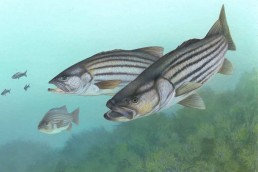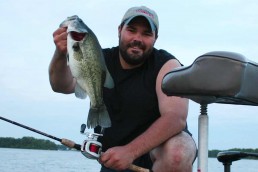Out go the Lights with Stripes
SHARE THIS POST
Striped bass, white bass, and hybrid stripers, also called “wipers,” are some of the most exciting freshwater fish. These pelagic species school together in groups and actively roam around the waters hunting prey. When you locate a school of hungry line-siders, action is often fast and furious.
These predatory fish tear into schools of baitfish, with a reckless abandon. They’re aggressive animals and a wide multitude of presentations can often work for heart-pounding action.
Location factors
Finding stripes is simple—locate the prey and you’ll find predators. In spring, pre-spawn fish ascend tributary arms of lakes and reservoirs or up feeder creeks on rivers. These places often hold lots of herring, shad, chubs, shiner minnows and other baitfish species. After spawning, they move back toward deeper, more open, main-lake or river areas for the summer period. During fall, baitfish will migrate into bays, coves and creeks, where whites and stripers won’t be far. As winter takes hold, fish head back to the deep main-lake basins or deeper primary river channel locations that are more open.
Keep an eye on your sonar and watch for schools of bait and bass along the bottom or suspended in the water column. Predatory birds also provide location clues as they feed on the same baitfish. Another way to find these species is to visually scan the water looking for schools of bait on or near the surface. Many times, you’ll also spot surface-feeding bass as they tear into prey balls. A hat and a quality pair of polarized fishing sunglasses are must-have items here. Polarized lenses allow anglers to spot bait and bass at greater depths and longer distances away. Optics like the Master Angler Series glasses from Flying Fisherman (flyingfisherman.com), maximize our ability to locate the best areas to fish.
Presentation and tackle
Surface lures take shallow fish well during much of the year. Chuggers, walking plugs, buzzbaits and prop baits are just a few effective options. Throw these lures right into a school of busting bass and you’re likely to get bit. When temperate bass hold in deeper water, crankbaits can produce well. Choose cranks based on the depths of where the fish are. Most do have depth limitations, so they can only be fished to a certain level, a drawback with this style of lure. Spoons, blade baits and in-line spinners also take whites and stripers.
Are you enjoying this post?
You can be among the first to get the latest info on where to go, what to use and how to use it!
White bass, striped bass and wipers do prey on other items, but the majority of their diet is shad and other pelagic baitfish. Because of this fact, long-arm, multi-blade, safety pin-style spinnerbaits are a top option in most situations. Lures like the CST School N Shad and Hatchet Shad (colbysimmsoutdoors.com) skirted long-arm spinnerbaits are unique. They feature three, four or five blades—depending on the model—in willows or hatchets, as well as swimbait bodies, for a school-of-baitfish “look” that temperate bass find irresistible.
Choose a quality medium-power rod of 6 1/2 to 8 feet in length for targeting white bass, wipers and small-to-average stripers, or, step up to a heavy-power rod up to 9 feet long for medium to large stripers and bigger-than-average hybrids. Match it up with a reel that has a super-smooth drag. Casting and spinning gear can both work, but casting is preferred for the bigger fish. Depending on fish size and cover, when targeting both species together, we often use 8- to 14-pound-test with spinning equipment or 10- to 17-pound-test with baitcasting gear for whites, hybrids and smaller or average stripers. And then sometimes we step up to 20- to 25-pound-test in waters with any big stripers. Or, sometimes we will choose a superbraid from about 40- to 80-pound-test with a smaller diameter.
Colby Simms is a professional fisherman, media personality, guide and owner of Colby Simms Outdoors Group. He runs a guide service, sells tackle and books on guided fishing and hunting trips. Contact: colbysimmsoutdoors@hotmail.com or call at 618-521-0526 or 573-358-5948.
MWO
SHARE THIS POST
Did you enjoy this post?
You can be among the first to get the latest info on where to go, what to use and how to use it!
Colby Simms
Colby Simms is a professional fisherman, media personality, guide and owner of Colby Simms Outdoors Group. He runs a guide service booking guided fishing and hunting trips, and sells tackle. Contact him at colbysimmsoutdoors@hotmail.com, Facebook @ColbySimmsOutdoors and @ColbySimmsSportFishingPro, or 618-521-0526 or 573-358-5948.



